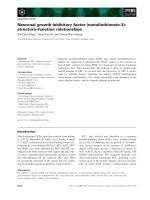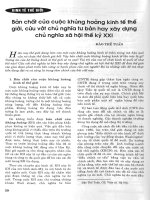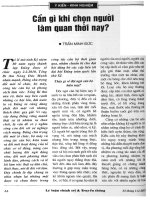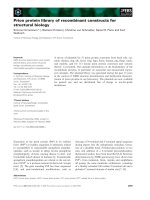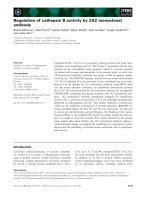Tài liệu Báo cáo khoa học: "Parsing, Projecting & Prototypes: Repurposing Linguistic Data on the Web" doc
Bạn đang xem bản rút gọn của tài liệu. Xem và tải ngay bản đầy đủ của tài liệu tại đây (233.85 KB, 4 trang )
Proceedings of the EACL 2009 Demonstrations Session, pages 41–44,
Athens, Greece, 3 April 2009.
c
2009 Association for Computational Linguistics
Parsing, Projecting & Prototypes: Repurposing
Linguistic Data on the Web
William D. Lewis
Microsoft Research
Redmond, WA 98052
Fei Xia
University of Washington
Seattle, WA 98195
1 Introduction
Until very recently, most NLP tasks (e.g., parsing, tag-
ging, etc.) have been confined to a very limited number
of languages, the so-called majority languages. Now,
as the field moves into the era of developing tools for
Resource Poor Languages (RPLs)—a vast majority of
the world’s 7,000 languages are resource poor—the
discipline is confronted not only with the algorithmic
challenges of limited data, but also the sheer difficulty
of locating data in the first place. In this demo, we
present a resource which taps the large body of linguis-
tically annotated data on the Web, data which can be re-
purposed for NLP tasks. Because the field of linguistics
has as its mandate the study of human language—in
fact, the study of all human languages—and has whole-
heartedly embraced the Web as a means for dissemi-
nating linguistic knowledge, the consequence is that a
large quantity of analyzed language data can be found
on the Web. In many cases, the data is richly annotated
and exists for many languages for which there would
otherwise be very limited annotated data. The resource,
the Online Database of INterlinear text (ODIN), makes
this data available and provides additional annotation
and structure, making the resource useful to the Com-
putational Linguistic audience.
In this paper, after a brief discussion of the previous
work on ODIN, we report our recent work on extend-
ing ODIN by applying machine learning methods to
the task of data extraction and language identification,
and on using ODIN to “discover” linguistic knowledge.
Then we outline a plan for the demo presentation.
2 Background and Previous work on
ODIN
ODIN is a collection of Interlinear Glossed Text (IGT)
harvested from scholarly documents. In this section,
we describe the original ODIN system (Lewis, 2006),
and the IGT enrichment algorithm (Xia and Lewis,
2007). These serve as the starting point for our current
work, which will be discussed in the next section.
2.1 Interlinear Glossed Text (IGT)
In recent years, a large part of linguistic scholarly dis-
course has migrated to the Web, whether it be in the
form of papers informally posted to scholars’ websites,
or electronic editions of highly respected journals. In-
cluded in many papers are snippets of language data
that are included as part of this linguistic discourse.
The language data is often represented as Interlinear
Glossed Text (IGT), an example of which is shown in
(1).
(1) Rhoddodd yr athro lyfr i’r bachgen ddoe
gave-3sg the teacher book to-the boy yesterday
“The teacher gave a book to the boy yesterday”
(Bailyn, 2001)
The canonical form of an IGT consists of three lines:
a language line for the language in question, a gloss
line that contains a word-by-word or morpheme-by-
morpheme gloss, and a translation line, usually in En-
glish. The grammatical annotations such as 3sg on the
gloss line are called grams.
2.2 The Original ODIN System
ODIN was built in three steps. First, linguistic docu-
ments that may contain instances of IGT are harvested
from the Web using metacrawls. Metacrawling in-
volves throwing queries against an existing search en-
gine, such as Google and Live Search.
Second, IGT instances in the retrieved documents
are identified using regular expression “templates”, ef-
fectively looking for text that resembles IGT. An exam-
ple RegEx template is shown in (2), which matches any
three-line instance (e.g., the IGT instance in (1)) such
that the first line starts with an example number (e.g.,
(1)) and the third line starts with a quotation mark.
(2)
\s
*
\(\d+\).
*
\n
\s
*
.
*
\n
\s
*
\[‘’"].
*
\n
The third step is to determine the language of the
language line in an IGT instance. Our original work in
language ID relied on TextCat, an implementation of
(Cavnar and Trenkle, 1994).
As of January 2008 (the time we started our current
work), ODIN had 41,581 instances of IGT for 731 lan-
guages extracted from nearly 3,000 documents.
1
1
For a thorough discussion about how ODIN was origi-
nally constructed, see (Lewis, 2006).
41
2.3 Enriching IGT data
Since the language line in IGT data does not come with
annotations (e.g., POS tags, phrase structures), Xia and
Lewis (2007) proposed to enrich the original IGT and
then extract syntactic information (e.g., context-free
rules) to bootstrap NLP tools such as POS taggers and
parsers. The enrichment algorithm has three steps: (1)
parse the English translation with an English parser, (2)
align the language line and the English translation via
the gloss line, and (3) project syntactic structure from
English to the language line. The algorithm was tested
on 538 IGTs from seven languages and the word align-
ment accuracywas 94.1% and projection accuracy (i.e.,
the percentage of correct links in the projected depen-
dency structures) was 81.5%.
3 Our recent work
We extend the previous work in three areas: (1) im-
proving IGT detection and language identification, (2)
testing the usefulness of the enriched IGT by answer-
ing typological questions, and (3) enhancing ODIN’s
search facility by allowing structural and “construc-
tion” searches.
2
3.1 IGT detection
The canonical form of IGT, as presented in Section 2.1,
consists of three parts and each part is on a single line.
However, many IGT instances, 53.6% of instances in
ODIN, do not follow the canonical format for various
reasons. For instance, some IGT instances are missing
gloss or translation lines as they can be recovered from
context (e.g., other neighboring examples or the text
surrounding the instance); other IGT instances have
multiple translations or language lines (e.g., one part in
the native script, and another in a Latin transliteration).
Because of the irregular structure of IGT instances,
the regular expression templates used in the original
ODIN system performed poorly. We apply machine
learning methods to the task. In particular, we treat the
IGT detection task as a sequence labeling problem: we
train a classifier to tag each line with a pre-defined tag
set,
3
use the learner to tag new documents, and con-
vert the best tag sequence into a span sequence. When
trained on 41 documents (with 1573 IGT instances) and
tested on 10 documents (with 447 instances), the F-
score for exact match (i.e., two spans match iff they
are identical) is 88.4%, and for partial match (i.e., two
spans match iff they overlap)is 95.4%.
4
In comparison,
the F-score of the RegEx approach on the same test set
is 51.4% for exact match and 74.6% for partial match.
2
By constructions, we mean linguistically salient con-
structions, such as actives, passives, relative clauses, inverted
word orders, etc., in particular those we feel would be of the
most benefit to linguists and computational linguists alike.
3
The tagset extends the standard BIO tagging scheme.
4
The result is produced by a Maximum Entropy learner.
The results by SVM and CRF learners are similar. The details
were reported in (Xia and Lewis, 2008).
Table 1: The language distribution of the IGTs in
ODIN
Range of # of # of IGT % of IGT
IGT instances languages instances instances
> 10000 3 36,691 19.39
1000-9999 37 97,158 51.34
100-999 122 40,260 21.27
10-99 326 12,822 6.78
1-9 838 2,313 1.22
total 1326 189,244 100
3.2 Language ID
The language ID task here is very different from a typ-
ical language ID task. For instance, the number of lan-
guages in ODIN is more than a thousand and could po-
tentially reach several thousand as more data is added.
Furthermore, for most languages in ODIN, our training
data contains few to no instances of IGT. Because of
these properties, applying existing language ID algo-
rithms to the task does not produce satisfactory results.
As IGTs are part of a document, there are often
various cues in the document (e.g., language names)
that can help predict the language ID of the IGT in-
stances. We designed a new algorithm that treats the
language ID task as a pronoun resolution task, where
IGT instances are “pronouns”, language names are “an-
tecedents”, and finding the language name of an IGT
is the same as linking a pronoun (i.e., the IGT) to its
antecedent (i.e., the language name). The algorithm
outperforms existing, general-purpose language iden-
tification algorithms significantly. The detail of the al-
gorithm and experimental results is described in (Xia et
al., 2009).
Running the new IGT detection on the original three
thousand ODIN documents, the number of IGT in-
stances increases from 41,581 to 189,244. We then ran
the new language ID algorithm on the IGTs, and Table
1 shows the language distribution of the IGTs in ODIN
according to the output of the algorithm. For instance,
the third row says that 122 languages each have 100 to
999 IGT instances, and the 40,260 instances in this bin
account for 21.27% of all instances in ODIN.
5
3.3 Answering typological questions
Linguistic typology is the study of the classification
of languages, where a typology is an organization of
languages by an enumerated list of logically possible
types, most often identified by one or more structural
features. One of the most well known and well studied
typological types, or parameters, is that of canonical
word order, made famous by Joseph Greenberg(Green-
berg, 1963).
5
Some IGTs are marked by the authors of the crawled
documents as ungrammatical (usually with an asterisk “*”
at the beginning of the language line). Those IGTs are kept
in ODIN too because they could be useful to other linguists,
the same reason that they were included in the original docu-
ments.
42
In (Lewis and Xia, 2008), we described a means
for automatically discovering the answers to a number
of computationally salient typological questions, such
as the canonical order of constituents (e.g., sentential
word order, order of constituents in noun phrases) or
the existence of particular constituents in a language
(e.g., definite or indefinite determiners). In these ex-
periments, we tested not only the potential of IGT to
provide knowledge that could be useful to NLP, but
also for IGT to overcome biases inherent to the op-
portunistic nature of its collection: (1) What we call
the IGT-bias, that is, the bias produced by the fact that
IGT examples are used by authors to demonstrate a par-
ticular fact about a language, causing the collection of
IGT for a language to suffer from a potential lack of
representativeness. (2) What we call the English-bias,
an English-centrism in the examples brought on by the
fact that most IGT examples provide a translation in
English, which can potentially affect subsequent en-
richment of IGT data, such as through structural pro-
jection. In one experiment, we automatically found the
answer to the canonical word order question for about
100 languages, and the accuracy was 99% for all the
languages with at least 40 IGT instances.
6
In another
experiment, our system answered 13 typological ques-
tions for 10 languages with an accuracy of 90%. The
discovered knowledge can then be used for subsequent
grammar and tool development work.
The knowledge we capture in IGT instances—both
the native annotations provided by the linguists them-
selves, as well as the answers to a variety of typological
questions discovered in IGT—we use to populate lan-
guage profiles. These profiles are a recent addition to
the ODIN site, and are available for those languages
where sufficient data exists. Following is an example
profile:
<Profile>
<language code="WBP">Warlpiri</language>
<ontologyNamespace prefix="gold">
/></ontologyNamespace>
<feature="word_order"><value>SVO</value></feature>
<feature="det_order"><value>DT-NN</value></feature>
<feature="case">
<value>gold:DativeCase</value>
<value>gold:ErgativeCase</value>
<value>gold:NominativeCase</value>
. . .
</Profile>
3.4 Enhancing ODIN’s Value to Computational
Linguistics: Search and Language Profiles
ODIN provides a variety of ways to search across its
data, in particular, search by language name or code,
language family, and even by annotations and their re-
lated concepts. Once data is discovered that fits the
particular pattern that a user is interested in, he/she can
6
Some IGT instances are not sentences and therefore are
not useful for answering this question. Further, those in-
stances marked as ungrammatical (usually with an asterisk
“*”) are ignored for this and all the typological questions.
either display the data (where sufficient citation infor-
mation exists and where the data is relatively clean) or
locate documents in which the data exists. Additional
search facilities allow users to search across poten-
tially linguistically salient structures and return results
in the form of language profiles. Although language
profiles are by no means complete—they are subject
to the availability of data to fill in the answers within
the profiles—they provide a summary of automatically
available knowledge about that language as found in
IGT (or enriched IGT).
4 The Demo Presentation
Our focus in this demonstration will be on the query
features of ODIN. In addition, however, we will also
give some background on how ODIN was built, show
how we see the data in ODIN being used by both the
linguistic and NLP communities, and present the kind
of information available in language profiles. The fol-
lowing is our plan for the demo:
• Very brief discussion on the methods used to build
ODIN (as discussed in Section 2.2, 3.1, and 3.2)
• An overview of the IGT enrichment algorithm (as
discussed in Section 2.3).
• A presentation of ODIN’s search facility and
the results that can be returned, in partic-
ular language profiles (as discussed in Sec-
tion 3.3-3.4). ODIN’s current website is
Users
can also search ODIN using the OLAC
7
search
interfaces at the LDC
8
and LinguistList.
9
Some
search examples are given below.
4.1 Example 1: Search by Language Name
The opening screen for ODIN allows the user to search
the ODIN database by clicking a specific language
name in the left-hand frame, or by typing all or part
of a name (finding closest matches). Once a language
is selected, our search tool will list all the documents
that have data for the language in question. The user
can then click on any of those documents, and search
tool will return the IGT instances found in those doc-
uments. Following linguistic custom and fair use re-
strictions, only instances of data that have citations are
displayed. An example is shown in Figure 1. Search by
language and name is by far the most popular search in
ODIN, given the hundreds of queries executed per day.
4.2 Example 2: Search by Linguistic
Constructions
This type of query looks either at enriched data in the
English translation, or at the projected structures in the
7
Open Language Archives Community
8
/>9
LinguistList has graciously offered to host ODIN, and it
is being migrated to . Completion
of this migration is expected sometime in April 2009.
43
Figure 1: IGT instances in a document
target language data. Figure 2 shows the list of linguis-
tic constructions that are currently covered.
Suppose the user clicks on “Word Order: VSO”,
the search tool will retrieve all the languages in ODIN
that have VSO order according to the PCFGs extracted
from the projected phrase structures (Figure 3). The
user can then click on the Data link for any language in
the list to retrieve the IGT instances in that language.
Figure 2: List of linguistic constructions that are cur-
rently supported
5 Conclusion
In this paper, we briefly discussed our work on im-
proving the ODIN system, testing the usefulness of
the ODIN data for linguistic study, and enhancing the
search facility. While IGT data collected off the Web is
inherently noisy, we show that even a sample size of 40
IGT instances is large enough to ensure 99% accuracy
in predicting Word Order. In the future, we plan to con-
tinue our efforts to collect more data for ODIN, in order
to make it a more useful resource to the linguistic and
computational linguistic audiences. Likewise, we will
Figure 3: Languages in ODIN Determined to be VSO
further extend the search interface to allow more so-
phisticated queries that tap the full breadth of languages
that exist in ODIN, and give users greater access to the
enriched annotations and projected structures that can
be found only in ODIN.
References
John Frederick Bailyn. 2001. Inversion, Dislocation and Op-
tionality in Russian. In Gerhild Zybatow, editor, Current
Issues in Formal Slavic Linguistics.
W. B. Cavnar and J. M. Trenkle. 1994. N-gram-based text
categorization. In Proceedings of Third Annual Sympo-
sium on Document Analysis and Information Retrieval,
pages 161–175, Las Vegas, April.
Joseph H. Greenberg. 1963. Some universals of grammar
with particular reference to the order of meaningful el-
ements. In Joseph H. Greenberg, editor, Universals of
Language, pages 73–113. MIT Press, Cambridge, Mas-
sachusetts.
William D. Lewis and Fei Xia. 2008. Automatically Identi-
fying Computationally Relevant Typological Features. In
Proceedings of The Third International Joint Conference
on Natural Language Processing (IJCNLP), Hyderabad,
January.
William D. Lewis. 2006. ODIN: A Model for Adapting and
Enriching Legacy Infrastructure. In Proceedings of the e-
Humanities Workshop, Amsterdam. Held in cooperation
with e-Science 2006: 2nd IEEE International Conference
on e-Science and Grid Computing.
Fei Xia and William D. Lewis. 2007. Multilingual struc-
tural projection across interlinearized text. In Proceedings
of the North American Association of Computational Lin-
guistics (NAACL) conference.
Fei Xia and William D. Lewis. 2008. Repurposing Theoret-
ical Linguistic Data for Tool Development and Search. In
Proceedings of The Third International Joint Conference
on Natural Language Processing (IJCNLP), Hyderabad,
January.
Fei Xia, William D. Lewis, and Hoifung Poon. 2009. Lan-
guage ID in the Context of Harvesting Language Data off
the Web. In Proceedings of The 12th Conference of the Eu-
ropean Chapter of the Association of Computational Lin-
guistics (EACL), Athens, Greece, April.
44



